A simple cedarwood perfume blend contains cedarwood essential oil as its rich, woody base note, mixed with a carrier oil like jojoba at a 1:4 ratio. You'll need complementary middle notes (50%) and lighter top notes (30%) to balance the cedarwood base (20%). Common additions include citrus oils for brightness and floral notes for depth. Follow proper blending techniques and safety measures to create your own signature scent – there's so much more to explore in perfume making.
The Magic of Cedarwood as a Base Note
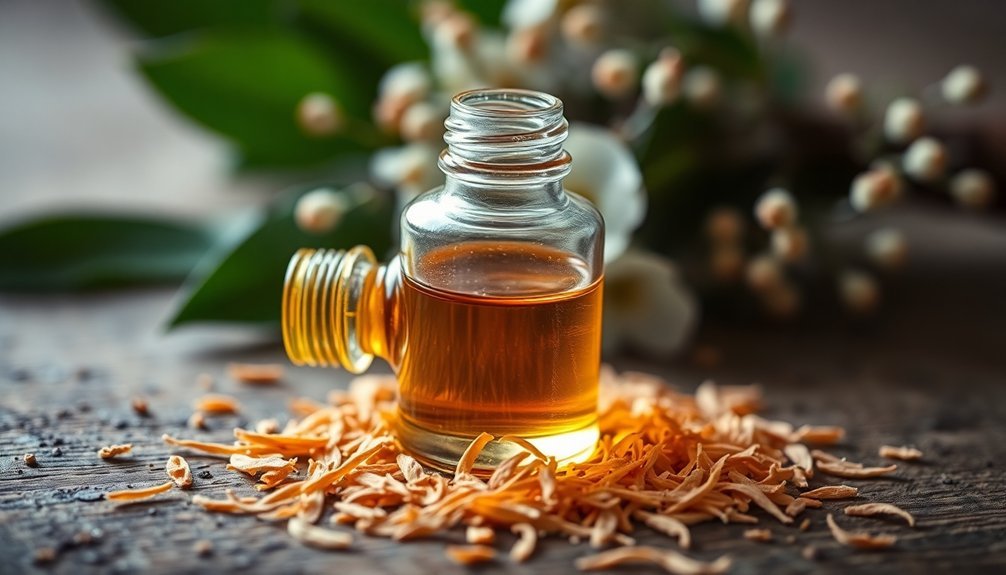
When perfumers seek to create a lasting fragrance, they often turn to cedarwood as their foundational base note. You'll find this versatile ingredient anchoring perfumes for hours while ensuring the scent remains consistent throughout wear. Its rich profile delivers everything from dry, smoky aromas to sweet, resinous notes that'll remind you of evergreen woodlands. Ancient civilizations valued cedarwood for its divine preservative qualities when preparing bodies for the afterlife.
What makes cedarwood truly magical is its exceptional blending ability. You'll discover it pairs beautifully with florals like rose and jasmine, while also complementing citrus, spicy, and other woody notes.
Its grounding properties don't just stabilize your fragrance – they're known to promote relaxation and focus too. Whether you're drawn to its therapeutic benefits or its ability to enhance spiritual awareness, cedarwood's role as a base note is truly transformative.
Essential Materials and Tools You'll Need
Creating a cedarwood perfume blend requires three essential categories of materials: your core oils, blending tools, and storage equipment.
You'll need cedarwood oil as your foundation, along with carrier oils for dilution and complementary essential oils like lavender or cypress for complexity. Both natural and synthetic cedarwood options are available depending on your desired authenticity and budget.
Your essential toolkit should include:
- Glass pipettes and precise scales for accurate measurements
- Dark glass bottles and roller balls for storage and application
- Protective gear like gloves and goggles for safe handling
Work in a well-ventilated space using clean blending vials and filtering equipment to guarantee your perfume's purity.
Don't forget to keep track of your materials' shelf life and store everything in a cool, dark place. A diffuser can help you test your blend's aromatic qualities before finalizing the formula.
Understanding Different Types of Cedarwood
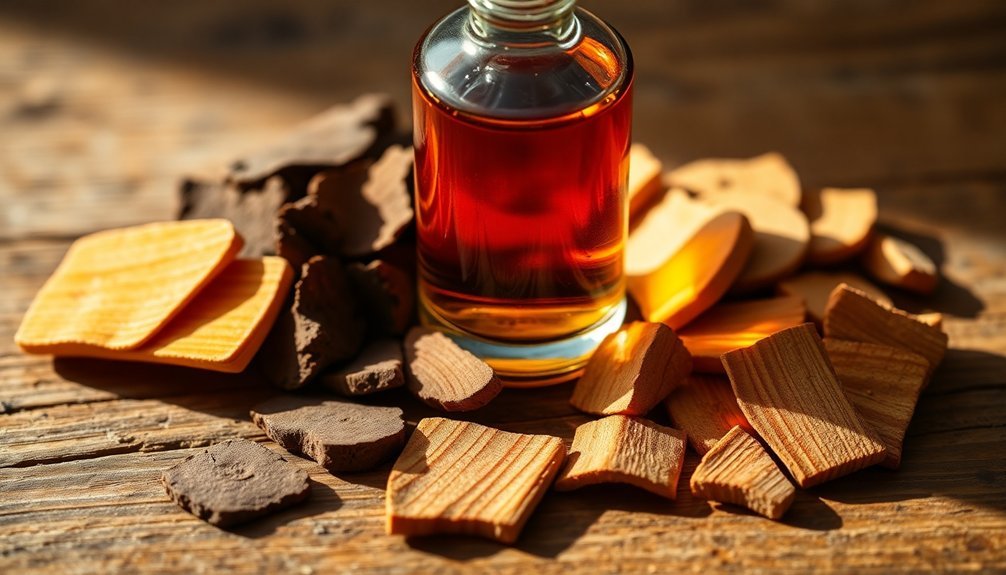
When creating cedarwood perfume blends, you'll encounter two main varieties: Atlas cedar with its warm, sweet undertones and Virginia cedar with its sharper, more herbal character.
The geographical origin of your cedarwood plays an essential role in its scent profile, with true cedars from North Africa and Asia offering distinct fragrances from false cedars native to North America. High-quality cedarwood often comes from the Atlas Mountains region, where the blue-green Atlas cedar species naturally thrives.
You can choose between raw cedarwood essential oils obtained through steam distillation or synthetic alternatives that aim to replicate these natural scent profiles.
Atlas vs. Virginia Cedar
Two prominent varieties of cedarwood dominate the perfume industry: Atlas and Virginia cedar. When you're choosing between them for your perfume blend, you'll notice distinct characteristics that set them apart.
Atlas cedar offers a warmer, woodier scent with balsamic undertones and sweet notes, making it perfect as a base note in complex fragrances. Virginia cedar presents a slightly different profile with its own unique sweetness.
- Atlas cedar blends beautifully with citrus, spice, and floral oils, making it more versatile in perfume creation.
- The wood of Atlas cedar is pale-brown and medium-weight, while being easy to work with despite its brittleness.
Both varieties undergo steam distillation for oil extraction, but they'll give you different therapeutic benefits – Atlas cedar excels at reducing anxiety and promoting relaxation.
Origins Shape Scent Profiles
The distinct geographic origins of cedarwood varieties directly influence their unique scent profiles.
You'll find that Himalayan cedarwood from India and Pakistan offers an earthy, spicy character, while Texan cedarwood from the American Southwest delivers warm, sweet woody notes with a pronounced smokiness.
The Virginian variety, sourced from the Appalachian Mountains, presents a fresh, woodsy aroma reminiscent of pencil shavings.
Atlas cedarwood, harvested from North Africa's Atlas Mountains, stands out with its rich woody scent and spicy-sweet undertones.
Each variety's distinct characteristics stem from its native environment and growing conditions.
When you're selecting a cedarwood fragrance, consider that these geographical differences create varying levels of earthiness, sweetness, and balsamic notes, making each type suitable for different perfume applications.
Raw vs. Synthetic Cedarwood
Understanding the distinction between raw and synthetic cedarwood opens up fascinating possibilities in perfumery.
Raw cedarwood, derived from Virginian and Texan varieties, offers an authentic, rustic woody scent reminiscent of freshly sharpened pencils. In contrast, synthetic alternatives like versafix and cedramber provide cleaner, sweeter profiles while serving as excellent fixatives.
Key differences you'll notice between raw and synthetic cedarwood:
- Raw cedarwood ages beautifully when stored properly, developing deeper complexity over time
- Synthetic versions offer more consistent scent profiles and enhanced longevity in perfume blends
- Raw cedarwood requires sustainable harvesting, while synthetics reduce environmental impact
Both types can work together harmoniously, allowing you to create balanced fragrances that capitalize on their unique strengths while meeting modern sustainability demands.
Selecting Complementary Fragrance Notes
Successfully creating a cedarwood perfume blend requires careful selection of complementary fragrance notes that enhance its woody character.
You'll want to contemplate pairing cedarwood with floral notes like rose or jasmine to create depth and complexity, while maintaining the wood's natural warmth. For a fresh twist, try adding citrus elements like bergamot or neroli, which can brighten the composition without overwhelming it.
If you're seeking a richer fragrance, combine cedarwood with oriental notes like amber or vanilla. These combinations create a luxurious, warm base that's perfect for fall and winter wear.
You can also experiment with herbal additions like lavender or spicy notes to add unexpected dimensions. Remember to balance the intensity of each note, starting with lighter scents and gradually building up to deeper, more complex layers.
Basic Blending Ratios and Proportions
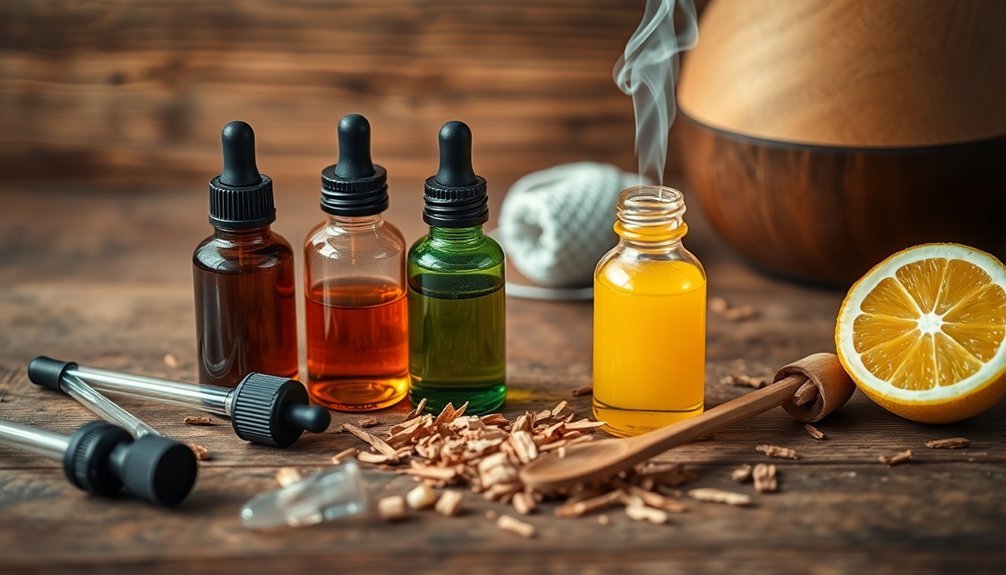
You'll need to understand the essential components of your cedarwood perfume blend, which follows the 30-50-20 rule: 30% top notes, 50% middle notes, and 20% base notes.
For a beginner's blend using cedarwood as your base note, start with a small 12-drop sample using 4 drops of top notes (like bergamot), 6 drops of middle notes (like lavender), and 2 drops of cedarwood.
Once you've created your essential oil blend, mix it with your carrier oil at a ratio of 1:4 (one part essential oils to four parts carrier oil) for a wearable perfume.
Essential Oil Main Components
The art of blending Cedarwood essential oil starts with its powerful base note components, primarily β-Himachalene (35-55%), α-Himachalene (10-25%), and γ-Himachalene (2-15%).
These constituents come from the wood of Cedrus atlantica, a majestic tree native to Morocco, through steam distillation.
When you're working with Cedarwood in your perfume blends, you'll want to understand its key characteristics:
- Acts as a fixative, helping your fragrance last longer
- Requires dilution with carrier oils like jojoba or sweet almond
- Must be stored in amber glass bottles to protect its potent compounds
You'll notice Cedarwood's rich woody aroma creates a solid foundation for your perfume.
Its molecular structure makes it particularly effective at anchoring more volatile top notes while adding depth to your final composition.
Beginner's Proportions Guide
Creating balanced perfume blends starts with three essential ratios: 30% top notes, 50% middle notes, and 20% base notes. You'll find this ratio works well for most beginner blends, though you can explore alternatives like 1:1:1 or 3:2:1 as you gain confidence.
For a simple 10-drop blend with cedarwood, try this breakdown:
- 3 drops of top notes (citrus or herbal)
- 5 drops of middle notes (floral or spicy)
- 2 drops of base notes (including cedarwood)
| Ratio Type | Top:Middle:Base | Best For |
|---|---|---|
| Classic | 30:50:20 | Balanced blends |
| Equal Parts | 1:1:1 | Light fragrances |
| Traditional | 3:2:1 | Stronger scents |
| Modern | 4:2:1 | Fresh aromas |
Remember to adjust these proportions based on your oils' strengths and your preferred scent profile.
Step-by-Step Mixing Process
Making a cedarwood perfume blend requires a methodical approach that starts with gathering your essential oils and base ingredients.
You'll begin by selecting your jojoba oil base and preparing your blending station with clean containers and droppers.
Following the drop-by-drop technique, start your blend with your chosen proportions:
- Add cedarwood oil first as your base note, swirling gently and taking time to assess its aroma.
- Layer in your middle notes like lavender or cardamom, adding one drop at a time while recording each addition.
- Finish with citrus top notes, carefully blending until you achieve your desired scent profile.
Once you've reached your target ratios, let the mixture rest for 24-48 hours.
This allows the notes to harmonize and reveals whether you'll need to make any final adjustments.
Aging and Storage Guidelines
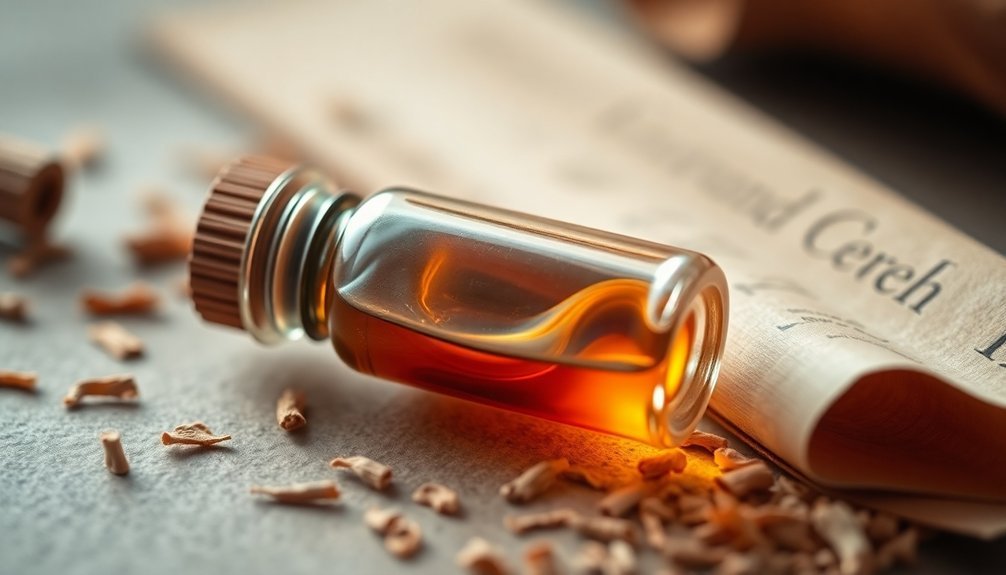
Proper storage of your cedarwood perfume blend plays an essential role in preserving its rich aroma and extending its lifespan.
Store your blend in a cool, dark place at temperatures between 15-25°C, away from direct sunlight and heat sources. Don't keep it in your bathroom, as humidity can affect the fragrance quality.
Always keep your perfume bottle tightly sealed and stored upright to prevent oxidation. If possible, store it in its original packaging for extra protection against light and moisture.
You'll want to minimize air exposure and avoid shaking the bottle unnecessarily. With proper storage, your unopened blend can last 3-5 years, while opened bottles typically maintain their quality for 1-2 years.
Check regularly for any changes in color or scent that might indicate degradation.
Safety Precautions and Best Practices
While storing your cedarwood perfume blend correctly helps maintain its quality, following strict safety measures secures your well-being during handling and application.
You'll need proper protective equipment, including chemical-resistant gloves and safety goggles with side shields when working with concentrated oils.
Essential safety practices you should follow:
- Never handle perfume materials without adequate ventilation, especially in confined spaces.
- Keep your workspace clear of food, drinks, and avoid smoking during blending.
- Always wash your hands thoroughly with soap after handling ingredients.
If accidental contact occurs, rinse affected areas immediately with water. In case of eye contact, remove contact lenses if possible and flush thoroughly.
Store your perfume materials in a cool place on an impermeable surface, away from incompatible materials, and verify containers remain tightly sealed.
Variations and Creative Combinations
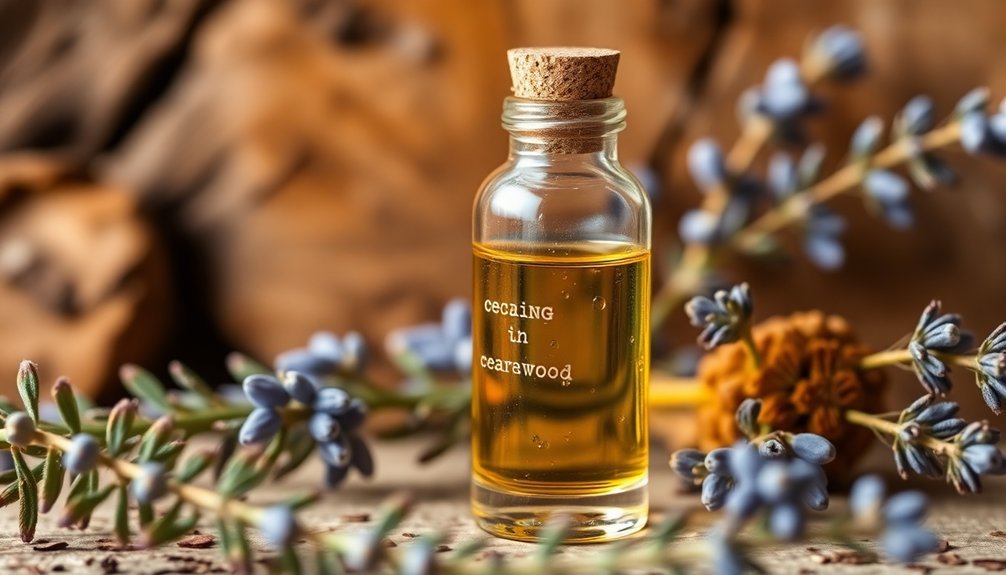
The versatility of cedarwood opens up endless possibilities for creating unique and enchanting fragrances. You'll find that mixing cedarwood with different notes can transform your perfume from woody to fresh, spicy to floral.
| Category | Popular Combinations |
|---|---|
| Woody | Vetiver, Patchouli, Sandalwood |
| Citrus | Bergamot, Grapefruit, Wild Orange |
| Floral | Lavender, Rose, Jasmine |
| Spicy | Coriander, Pink Pepper, Nutmeg |
For a masculine scent, try blending cedarwood with patchouli and leather notes. If you're seeking something lighter, combine it with bergamot and grapefruit for a fresh, uplifting experience. Create an elegant evening perfume by mixing cedarwood with rose Damascus and violet, or opt for a spicy-woody blend using oud and coriander.
Frequently Asked Questions
Can Cedarwood Perfume Trigger Allergies in People Sensitive to Wood-Based Products?
Yes, if you're sensitive to wood products, you can experience allergic reactions to cedarwood perfume. It contains compounds like cedrol and thujopsene that may trigger skin irritation, respiratory issues, or contact dermatitis.
How Long Does Homemade Cedarwood Perfume Typically Last Before Going Bad?
Your homemade cedarwood perfume will typically last 1-3 years if it's alcohol-based, or about a year if oil-based. You'll need proper storage in a cool, dark place with airtight sealing.
Will Cedarwood Perfume Attract or Repel Insects When Worn Outdoors?
Your cedarwood perfume will actively repel insects, especially ticks and mosquitoes. It's particularly effective in the first 30 minutes, but you'll need to reapply hourly for continued protection during outdoor activities.
Does Natural Cedarwood Perfume Stain Clothing or Fabric?
Yes, natural cedarwood perfume can stain your clothing. The oil's dark color and carrier ingredients may leave marks, especially on light fabrics. You'll want to let it dry before clothing contact to minimize staining.
Can Cedarwood Perfume Be Layered With Commercial Fragrances?
Yes, you can layer cedarwood perfume with commercial fragrances. It works especially well with citrus, floral, and woody scents. You'll get the best results when you start with cedarwood as your base note.
In Summary
Now you're ready to create your own cedarwood perfume blend at home. With the right materials, proper ratios, and careful mixing techniques, you'll craft a unique fragrance that captures cedarwood's timeless appeal. Remember to store your creation properly and let it age for the best results. Don't be afraid to experiment with different complementary notes to develop your signature scent. Happy blending!

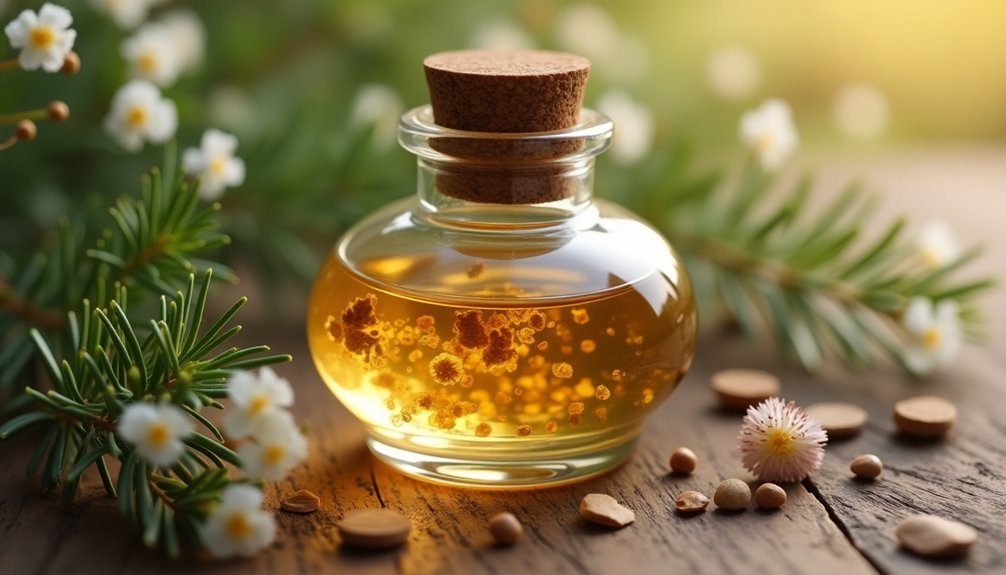



Leave a Reply